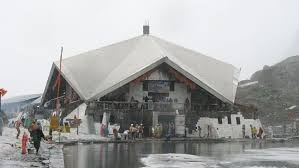Sikh devotee dies after slipping into ditch near Hemkund Sahib in Uttarakhand

Chamoli, Uttarakhand – What began as a spiritual journey to one of Sikhism’s holiest shrines ended in tragedy for 18-year-old Gurpreet Singh from Amritsar, Punjab. The young pilgrim died on Sunday after slipping into a 100-meter-deep ditch along the route to Hemkund Sahib, sending shockwaves through the Sikh community and sparking fresh debates over safety on the high-altitude trail.
The incident occurred while Gurpreet was trekking with a group of around 90 pilgrims. According to local authorities, the teenager took a fenced-off shortcut that was closed to the public, eventually losing his footing on the steep, slippery terrain.
A Sacred Journey Turned Fatal
Hemkund Sahib, perched at an altitude of over 15,000 feet in the Garhwal Himalayas, is a revered Sikh pilgrimage site visited by thousands each year. The path leading to it, however, is known to be treacherous, particularly during the monsoon months. Slippery slopes, steep climbs, and sudden weather changes pose serious challenges to even seasoned trekkers.
Gurpreet, described by fellow pilgrims as cheerful and enthusiastic, was eager to reach the sacred gurudwara. But somewhere near the trail, he reportedly attempted to take an older route—barred and barricaded by local authorities due to its dangers. Despite clear signage and fencing, the youth bypassed the main trail, slipped, and plummeted into a deep gorge below.
Rescue teams, including the State Disaster Response Force (SDRF), local police from Govindghat, and volunteers, were immediately deployed. After hours of searching, they recovered his body and transported it to a nearby hospital, where he was declared dead on arrival.
Safety Warnings Ignored
This tragedy has reignited conversations around pilgrim safety during the Hemkund Sahib yatra. Authorities have long cautioned against deviating from designated trekking paths, especially shortcuts that may appear quicker but are fraught with hidden dangers.
“The barricade was there for a reason,” said a Chamoli district official. “These old paths are unstable and prone to landslides. It’s heartbreaking that such a young life was lost for the sake of a shortcut.”
The incident is not isolated. Gurpreet’s death marks the fourth fatality since the Hemkund yatra began in May this year. Two pilgrims, including a 74-year-old man, reportedly died due to medical conditions worsened by high altitude. Another victim, 32-year-old Karamjit Singh, was killed earlier in June after being hit by falling boulders near Atalakoti.
The Allure and Risk of Hemkund Sahib
Located near the Valley of Flowers in Uttarakhand, Hemkund Sahib is not just a spiritual destination—it is a trek that tests physical and mental endurance. The steep climb from Ghangaria to Hemkund spans about 6 kilometers, but the altitude gain is significant. For first-time trekkers or older devotees, this can be dangerously exhausting.
Monsoon season adds to the challenge. Heavy rains can turn paths into streams and loosen rocks, making slips and landslides common.
Despite the inherent dangers, thousands of devotees undertake the yatra each year, driven by devotion and a deep spiritual calling. But as incidents like Gurpreet’s remind us, reverence must be balanced with caution.
Voices from the Ground
The local administration and Sikh organizations have expressed grief over the incident.
“This is a deeply unfortunate loss. We pray for the strength of the family,” said a spokesperson from the Shiromani Gurdwara Parbandhak Committee (SGPC), which helps organize parts of the pilgrimage.
Meanwhile, volunteers who assist pilgrims along the trail say more needs to be done to educate yatris on safety protocols.
“We see many people trying to bypass the trail, thinking they’ll save time. But they don’t understand the risk. We need stricter enforcement and better signage,” said Amarjeet Singh, a volunteer from Punjab.
Some pilgrims believe mandatory safety briefings should be introduced for groups before beginning the climb from Govindghat or Ghangaria.
What Can Be Done?
In the wake of this tragedy, experts and community leaders are calling for stronger measures to protect pilgrims:
- Stricter enforcement: Authorities must ensure that closed routes are not accessible at all, even if it means placing guards or CCTV surveillance at key points.
- Safety orientation: Before beginning the trek, especially during monsoon, pilgrims should be given a short briefing about dangers, safe routes, and what to do in case of emergencies.
- Physical preparedness: Trekkers should be encouraged to check their health status and avoid pushing themselves if they feel unwell.
- Clearer signage: Warning signs in multiple languages, especially Hindi and Punjabi, should be placed at regular intervals on the route.
A Lesson in Caution
Gurpreet Singh’s death is a sobering reminder of the thin line between devotion and danger. While the journey to Hemkund Sahib remains sacred and soul-stirring, it must not come at the cost of lives.
As yatris prepare for future treks, especially during unpredictable weather, the message is clear: the holy path is best followed, not fast-tracked.
Conclusion:
The loss of a young life in such a revered setting is not just tragic—it is preventable. By reinforcing safe practices, respecting closures, and taking personal responsibility, devotees can honor both their faith and their well-being.






